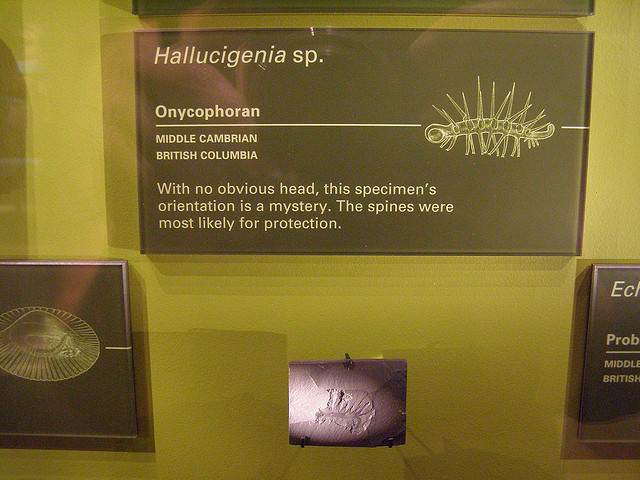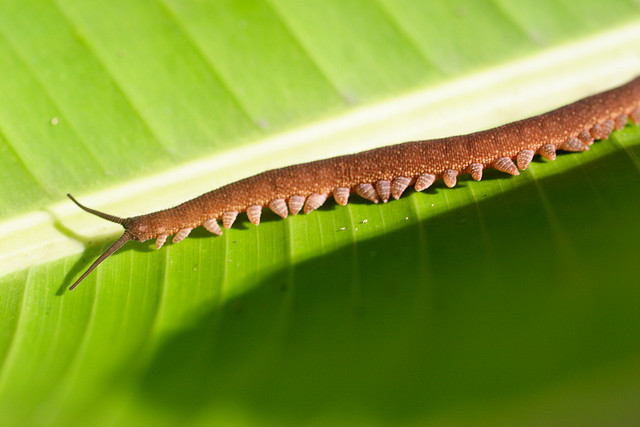The New Weird Cambrian Organisms are in early this year, and the latest design is a trippy walking stick called Diania cactiformis(click link for image). Scientists are calling it “the walking cactus”. If Henson Studios was in charge of making life on Earth, one of their designs would probably be something like this — with googly eyes, of course.
But before we take a closer look, let’s take a step back . . .
This is Hallucigenia. It is an odd creature, one who has been reconstructed both right side up and upside down (presuming only one of the directions was correct in real life, which given the general weirdness of early life, may not be a safe assumption), and which of the two the current reconstructions is correct may still be anyone’s guess. It has been interpreted variously as walking on pointy tentacles with flexible feeding arms on its back, or walking on flexible feet with pointy spines on its back (the currently favored interpretation, pictured above).
It was such an odd duck that the famous paleontologist Simon Conway Morris, whose study of bizarre Cambrian animals in the Burgess Shale Stephen Jay Gould wrote about in the book Wonderful Life, named it after a hallucination. Morris also happened to originally reconstruct the animal in the currently non-accepted fashion, meaning perhaps that with creatures so strange, even great paleontologists can be fooled (we saw that that was the case for Anomalocaris too).
Hallucigenia was probably a lobopod, a type of creature with hollow, lobe-like legs that are extensions of the body wall. The fossil beds are full of strange incarnations of lobopods, some of which you should see here, here, and here to get a sense of the variation and general weirdness in the group.
But the creature debuted this week in nature may take the cake. (Alas — I lack copyright permission to use the images, so check out Ed Yong’s photos of the fossils here.) One cannot help but compare Diania to a first-grader’s pipe-cleaner art project. It is shockingly, wonderfully, delightfully weird. Can you imagine this thing shambling along the bottom of the Cambrian* oceans? What was it eating? How did it . . . er. . . make little walking cacti?
Aside from the delight that their sheer beauty and knowledge of their existence inspires, these organisms are important for another reason. They may have been among the ancestors of the arthropods, the tremendously successful joint-legged creatures that include insects, millipeds, and crustaceans.For, true to name, they appear to have hardened, jointed legs. But unlike arthropods, their bodies are not. The authors of the paper in Nature that revealed this creature to the world suggest that that may mean jointed legs came before jointed bodies, meaning the name “arthropod” (jointed foot) for the group was well chosen indeed.
Scientists were especially excited by the find because they had lacked any intermediate forms between the apparently soft-bodied lobopod fossils and the stiff and jointy arthropods. This looks like evidence of life in that transition.
What would Diania have looked like in real life, and how would those spindly legs have moved? Living lobopods — the modern day relatives of Diania — might give us a clue. Today, there are probably only two surviving members of the lobopod group — the velvet worms,
and the water bears, or tardigrades (remember?). Tardigrades are the foil-hatted survivalists of the animal world, withstanding pure alcohol, the vacuum of space, temperatures from -272 to 149 degrees C and ionizing radiation with remarkable aplomb. It’ll be them, cockroaches, and twinkies in the fallout of the apocalypse. Yet belying that ability is their adorable plush appearance, as they trundle along on their cute little claw-footed stumpy legs, as you can see in this video.
They can live practically anywhere — from moss to the deep sea to hot springs.
Velvet worms, on the other hand, are skilled predators with an incredible way to snare their prey. As usual, David Attenborough puts it best in this video:
They tend to be arrestingly textured, brightly colored or even iridescent, and favor moist places, perhaps because their somewhat-hardened skins are not very water-tight.
Although both velvet worms and water bears have somewhat hardened coverings that they periodically moult and stumpy conical legs that end in claws (like many fossil lobopodans), they are not jointed. Scientists have been confused by their relationships to each other and to the arthropods. They have many traits in common or diverging from the arthropods and each other. Velvet worms, in particular, have stirred up controversy, having been suggested to be everything from slugs or polychaete worms to degenerate arthropods that are close insect and millipede relatives to one-half of some sort of unholy hybrid velvet worm-butterfly union that produced caterpillars (most scientists have scoffed at this).
As a result, most trees depicting the relationship have shown water bears, velvet worms, and arthropods as a three-tined fork on the Earth family tree. All the extinct lobopods fit in and around these branches. If you were going to stick Diania in there, as the authors of the Nature paper do, you’d place it closer to the arthropods than either the water bears or velvet worms, making a new two-pronged fork. Though it’s possible Diania is a direct ancestor of arthropods, it may be more likely that Diania mearly shares a similar looking common ancestor with arthropods and ultimately represents a failed life experiment. Those of you craving a closer look that incorporates a host of extinct Cambrian fauna on a hypothetical tree can find a more detailed one from the paper here.
Phil Plait (the Bad Astronomer) likes to say,”The universe is cool enough without making crap up about it”, or something like that. Diania — and Hallucigenia, and water bears, and velvet worms — certainly seems to help make his case.
_______________________________________________
* the time period of the second major explosion of multicellular life — the one that generated the ancestors of most modern critters




{ 2 trackbacks }
{ 3 comments… read them below or add one }
um, awesome. and i like “foil-hatted survivalists” :) :)
Don’t be hating on Lynn, Jen! She was right about mitochondria. She may not be right about holometabolous insects, but it’s worth thinking about. People may lampoon Williams’ paper with jokes about mayflies and velvet worms getting WAY too drunk, but what about some kind of virally-mediated gene transfer? Very low probability, sure, but million of years and billions of insects make the idea remotely possible, if not super plausible.
For the record, I think that a more plausible explanation for the simplified anatomy of larval holometabolous insects is selection against limbs in some ancestral, burrowing larva. But don’t hate on Lynn!
Spoken like a true Amherst alum. : )
Personally, I’d be much more inclined to give it credence had this all be hypothesized for the ocean, where gametes mingle like cocktail party guests. But in this post, I just be repeatin’ what othas is sayin’. Don’t hate the playa, Ben, hate the game. ; )